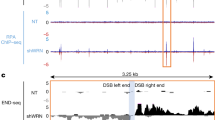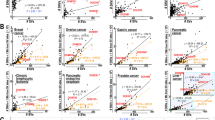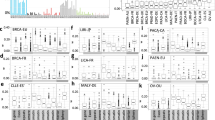Abstract
Repetitive tracts within the coding regions of TGFBR2 and BAX are frequently mutated in mismatch repair deficient tumours and are implicated in tumour progression. However, there has been little study of the balance between selection pressure and inherent instability at sequences within these genes. To determine whether TGFBR2 and BAX are inherently prone to mutations in the presence of MMR defects, we studied MMR deficient cells derived from B-lymphocytes. By analysing cells derived from normal tissue we aimed to minimize the effects of selection pressures that bias the apparent frequency of mutation. We definitively show that certain sequences, usually repaired by MMR, are inherently unstable. Using a small pool PCR technique we confirmed these cells exhibit microsatellite instability. Additionally, we demonstrate that MMR deficiency results in an excess of mutations, specifically at the poly(A)10 tract compared to other regions of the TGFBR2 gene (P<0.001). Conversely, an excess of mutations does not appear to arise at the poly(G)8 tract of the BAX gene. These studies provide insight into the mechanism by which TGFBR2 and BAX genes become mutated during tumorigenesis. These findings invoke the notion of ‘unmasking’ specific hypermutable sequences in particular genes adding further complexity to the concept of the mutator phenotype.
This is a preview of subscription content, access via your institution
Access options
Subscribe to this journal
Receive 50 print issues and online access
$259.00 per year
only $5.18 per issue
Buy this article
- Purchase on Springer Link
- Instant access to full article PDF
Prices may be subject to local taxes which are calculated during checkout




Similar content being viewed by others
References
Aaltonen LA, Peltomaki P, Leach FS, Sistonen P, Pylkkanen L, Mecklin JP, Jarvinen H, Powell SM, Jen J, Hamilton SR . 1993 Science 260: 812–816
Abdel-Rahman WM, Georgiades IB, Curtis LJ, Arends MJ, Wyllie AH . 1999 Oncogene 18: 2139–2142
Bacon AL, Dunlop MG, Farrington SM . 2001 Nucleic Acids Res. in press
Bacon AL, Farrington SM, Dunlop MG . 2000 Hum. Mol. Genet. 9: 2707–2713
Boland CR, Thibodeau SN, Hamilton SR, Sidransky D, Eshleman JR, Burt RW, Meltzer SJ, Rodriguez-Bigas MA, Fodde R, Ranzani GN, Srivastava S . 1998 Cancer Res. 58: 5248–5257
Cahill DP, Kinzler KW, Vogelstein B, Lengauer C . 1999 Trends Cell Biol. 9: M57–M60
Carethers JM, Pham TT . 2000 In Vivo 14: 13–20
Dietmaier W, Wallinger S, Bocker T, Kullmann F, Fishel R, Ruschoff J . 1997 Cancer Res. 57: 4749–4756
Eppert K, Scherer SW, Ozcelik H, Pirone R, Hoodless P, Kim H, Tsui LC, Bapat B, Gallinger S, Andrulis IL, Thomsen GH, Wrana JL, Attisano L . 1996 Cell 86: 543–552
Grady WM, Rajput A, Myeroff L, Liu DF, Kwon K, Willis J, Markowitz S . 1998 Cancer Res. 58: 3101–3104
Grady WM, Myeroff LL, Swinler SE, Rajput A, Thiagalingam S, Lutterbaugh JD, Neumann A, Brattain MG, Chang J, Kim SJ, Kinzler KW, Vogelstein B, Willson JK, Markowitz S . 1999 Cancer Res. 59: 320–324
Inman GJ, Allday MJ . 2000 J. Gen. Vir. 81: 1567–1578
Ionov Y, Peinado MA, Malkhosyan S, Shibata D, Perucho M . 1993 Nature 363: 558–561
Lu SL, Kawabata M, Imamura T, Akiyama Y, Nomizu T, Miyazono K, Yuasa Y . 1998 Nat. Genet. 19: 17–18
Lu SL, Zhang WC, Akiyama Y, Nomizu T, Yuasa Y . 1996 Cancer Res. 56: 4595–4598
Markowitz S, Wang J, Myeroff L, Parsons R, Sun L, Lutterbaugh J, Fan RS, Zborowska E, Kinzler KW, Vogelstein B . 1995 Science 268: 1336–1338
Mironov N, Jansen LA, Zhu WB, Aguelon AM, Reguer G, Yamasaki H . 1999 Carcinogenesis 20: 2189–2192
Nicolaides NC, Littman SJ, Modrich P, Kinzler KW, Vogelstein B . 1998 Mol. Cell Biol. 18: 1635–1641
Ouyang H, Shiwaku HO, Hagiwara H, Miura K, Abe T, Kato Y, Ohtani H, Shiiba K, Souza RF, Meltzer SJ, Horii A . 1997 Cancer Res. 57: 1851–1854
Papadopoulos N, Lindblom A . 1997 Hum. Mutat. 10: 89–99
Parsons R, Myeroff LL, Liu B, Willson JK, Markowitz SD, Kinzler KW, Vogelstein B . 1995a Cancer Res. 55: 5548–5550
Parsons R, Li GM, Longley M, Modrich P, Liu B, Berk T, Hamilton SR, Kinzler KW, Vogelstein B . 1995b Science 268: 738–740
Pedroni M, Sala E, Scarselli A, Borghi F, Menigatti M, Benatti P, Percesepe A, Rossi G, Foroni M, Losi L, Di Gregorio C, De Pol A, Nascimbeni R, Di Betta E, Salerni B, de Leon MP, Roncucci L . 2001 Cancer Res. 61: 896–899
Rampino N, Yamamoto H, Ionov Y, Li Y, Sawai H, Reed JC, Perucho M . 1997 Science 275: 967–969
Shibata D, Peinado MA, Ionov Y, Malkhosyan S, Perucho M . 1994 Nat. Genet. 6: 273–281
Takenoshita S, Tani M, Nagashima M, Hagiwara K, Bennett WP, Yokota J, Harris CC . 1997 Oncogene 14: 1255–1258
Vilkki S, Tsao JL, Loukola A, Poyhonen M, Vierimaa O, Herva R, Aaltonen LA, Shibata D . 2001 Cancer Res. 61: 4541–4544
Wang CY, Eshleman JR, Willson JK, Markowitz S . 1995 Cancer Res. 55: 5101–5105
Wheeler JM, Beck NE, Kim HC, Tomlinson IP, Mortensen NJ, Bodmer WF . 1999 Proc. Natl. Acad. Sci. USA. 96: 10296–10301
Zhang L, Yu J, Willson JK, Markowitz SD, Kinzler KW, Vogelstein B . 2001 Cancer Res. 61: 3801–3805
Acknowledgements
We are grateful to Bert Vogelstein for the gift of cell lines lbl-1260 and lbl-1261. We acknowledge technical assistance from Sheila McBeath and assistance with flow cytometry from Martin Waterfall. This work was supported by the following grants; Cancer Research Campaign (SP2326/0201), Scottish Health Department (K-/MRS/50/C2723), The Melville Trust, Edinburgh University Cancer Research Endowment Fund and Urquart Charitable Trust. AL Bacon was funded by MRC PhD Student Fellowship, SM Farington by an RSE Personal Research Fellowship.
Author information
Authors and Affiliations
Corresponding author
Rights and permissions
About this article
Cite this article
Bacon, A., Farrington, S. & Dunlop, M. Mutation frequency in coding and non-coding repeat sequences in mismatch repair deficient cells derived from normal human tissue. Oncogene 20, 7464–7471 (2001). https://doi.org/10.1038/sj.onc.1204973
Received:
Revised:
Accepted:
Published:
Issue Date:
DOI: https://doi.org/10.1038/sj.onc.1204973
Keywords
This article is cited by
-
Current research in perineural invasion of cholangiocarcinoma
Journal of Experimental & Clinical Cancer Research (2010)
-
MLH1 mediates PARP-dependent cell death in response to the methylating agent N-methyl-N-nitrosourea
British Journal of Cancer (2009)
-
TGFβ: the molecular Jekyll and Hyde of cancer
Nature Reviews Cancer (2006)



